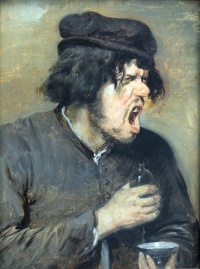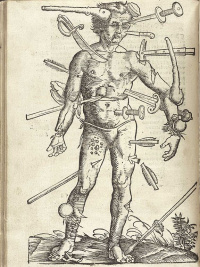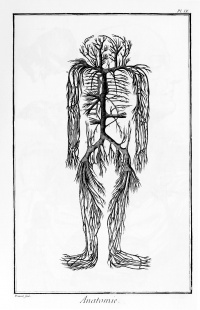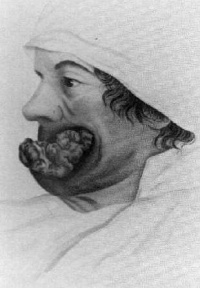Medicine
From The Art and Popular Culture Encyclopedia
| Revision as of 22:12, 18 July 2007 WikiSysop (Talk | contribs) ← Previous diff |
Current revision Jahsonic (Talk | contribs) |
||
| Line 1: | Line 1: | ||
| + | [[Image:The Bitter Potion.jpg|200px|thumb|left|''[[The Bitter Potion]]'' (c. 1635) by [[Adriaen Brouwer]]]] | ||
| + | {| class="toccolours" style="float: left; margin-left: 1em; margin-right: 2em; font-size: 85%; background:#c6dbf7; color:black; width:30em; max-width: 40%;" cellspacing="5" | ||
| + | | style="text-align: left;" | | ||
| + | "I felt a little [[ill]] and called Dr. Symmachus.<br> | ||
| + | Well, you came, Symmachus, but you brought 100 [[medicine|medical student]]s with you.<br> | ||
| + | One hundred ice-cold hands poked and jabbed me.<br> | ||
| + | I didn't have a [[fever]], Symmachus, when I called you –but now I do. <br> | ||
| + | --[[The Epigrams|''Book V, No. 9'' of ''The Epigrams'']], Martial | ||
| + | <hr> | ||
| + | "Possibly, indeed, it was the [[anomalous]] that was largely instrumental in arousing in the savage the attention, thought, and investigation that were finally to develop into the body of organized truth which we now call [[Science]]."--''[[Anomalies and Curiosities of Medicine]]'' (1896) by George M. Gould and Walter Lytle Pyle | ||
| + | |} | ||
| + | [[Image:Wound Man.jpg|thumb|right|200px|[[Wound Man]]]] | ||
| + | [[Image:Demonstration of the mechanics of facial expression. Duchenne and an assistant faradize the mimetic muscles of The Old Man.jpg |thumb|right|200px|[[Old Toothless Man]] | ||
| + | <br>The image depicts the mechanics of [[facial expression]] while [[Duchenne]] and an assistant [[faradize]] the [[mimetic muscles]] of "The Old Man"]] | ||
| + | [[Image:Artery system from L'Encyclopédie.jpeg|thumb|right|200px|[[Les troncs de la veine cave avec leurs branches disséquées dans un corps adulte, &c. d'après les Transactions Philosophiques|Artery system from ''L'Encyclopédie'']]]] | ||
| + | [[Image:Tumor by Alibert.jpg|thumb|200px|right|[[Tumor]] by [[Alibert]], [[1833]]]] | ||
| {{Template}} | {{Template}} | ||
| - | == Medicine show == | + | '''Medicine''' is the [[applied science]] or practice of the [[diagnosis]], [[healing|treatment]], and prevention of [[disease]]. It encompasses a variety of [[health care]] practices evolved to maintain and restore [[health]] by the [[prevention (medical)|prevention]] and [[therapy|treatment]] of [[illness]] in [[human beings]]. |
| - | [[Medicine show]] | + | |
| - | Similar to the fabled gypsy bands of old Europe, '''medicine shows''' were traveling [[horse and buggy]] teams which peddled miracle medications and other products between various entertainment acts. Their precise origins unknown, medicine shows were most common in the [[United States]] in the [[19th century]] (though they continued up to [[World War II]]). The product most commonly associated with medicine shows is an [[elixir]] (also known as [[snake oil]]) which was touted to cure diseases, smooth facial wrinkles, remove stains in clothing, prolong life, or cure any number of common ailments. Entertainment often included a [[freak show]], a [[flea circus]], [[Musical ensemble|musical act]]s, [[Magic (illusion)|magic]] tricks, [[jokes]], and [[storytelling]]. The flea tricks were preformed on miniature circus equipment. | + | |
| - | The last (and arguably the largest and greatest) of these traveling shows was the ''Hadacol Caravan'', sponsored by [[Louisiana]] State Senator [[Dudley J. LeBlanc]] and his LeBlanc Corporation, makers of the dubious [[patent medicine]]/[[vitamin|vitamin tonic]] "[[Hadacol]]", known for both its alleged curative powers and its high alcohol content. The stage show, which barnstormed throughout the [[Deep South]] in the 1940s, featured a number of notable music acts and [[Cinema_of_the_United_States|Hollywood]] celebrities, and was used to promote Hadacol (which was sold heavily during intermission and after the show). Admission to the show was paid in boxtops of the vitamin tonic, sold in stores throughout the southern United States. The Caravan came to a sudden halt in 1951, when the Hadacol enterprise fell apart in a scandal. | + | The word ''medicine'' is derived from the [[Latin]] ''ars medicina'', meaning ''the art of healing''. |
| + | ==History== | ||
| + | The ancient Egyptians had a [[Ancient Egyptian medicine|system of medicine]] that was very advanced for its time and influenced later medical traditions. The Egyptians and Babylonians both introduced the concepts of [[diagnosis]], [[prognosis]], and [[medical examination]]. The Greeks went even further, and advanced as well [[medical ethics]]. The [[Hippocratic Oath]], still taken by doctors today, was written in Greece in the 5th century BCE. In the medieval era, surgical practices inherited from the ancient masters were improved and then systematized in [[Rogerius (physician)|Rogerius's]] ''The Practice of Surgery''. Universities began systematic training of physicians around the years 1220 in Italy. During the Renaissance, understanding of anatomy improved, and the microscope was invented. The [[germ theory of disease]] in the 19th century led to cures for many infectious diseases. Military doctors advanced the methods of trauma treatment and surgery. Public health measures were developed especially in the 19th century as the rapid growth of cities required systematic sanitary measures. Advanced research centers opened in the early 20th century, often connected with major hospitals. The mid-20th century was characterized by new biological treatments, such as antibiotics. These advancements, along with developments in chemistry, genetics, and lab technology (such as the [[x-ray]]) led to [[modern medicine]]. Medicine was heavily professionalized in the 20th century, and new careers opened to women as nurses (from the 1870s) and as physicians (especially after 1970). The 21st century is characterized by very advanced research involving numerous fields of science. | ||
| - | Several modern musical acts have named themselves after this old time phenomenon, including [[Old Crow Medicine Show]], [[Norman Greenbaum|Norman Greenbaum's]] [[Dr. West's Medicine Show and Junk Band]], [[Dr. Hook & The Medicine Show]] and the London based indie rock and roll band [[Medicine Show]]. It also lent its name to [[Big Audio Dynamite]]'s song "Medicine Show", and [[The Band]]'s "W.S. Walcott Medicine Show".{{GFDL}} | + | |
| + | == See also == | ||
| + | *[[History of medicine]] | ||
| + | *[[Disease]] | ||
| + | *[[Medical illustration]] | ||
| + | *[[Medical museum]] | ||
| + | *[[Medicine show]] | ||
| + | *[[Medicalization]] | ||
| + | *[[Anatomy]] | ||
| + | *[[Psychiatry]] | ||
| + | ==See also== | ||
| + | *[[Medical encyclopedia ]] | ||
| + | * [[Pill]] | ||
| + | * [[Surgery]] | ||
| + | * [[Neurosurgery]] | ||
| + | * [[Otolaryngology]] | ||
| + | * [[Organ transplantation|Transplant surgery]] | ||
| + | * [[Urology]] | ||
| + | ** [[Andrology]] | ||
| + | * [[Allergy]] / [[Immunology]] | ||
| + | * [[Endocrinology]] | ||
| + | * [[Infectious disease]] | ||
| + | * [[Obstetrics and gynaecology]] | ||
| + | * [[Gynaecology]] | ||
| + | * [[Pathology]] | ||
| + | * [[Anesthesia|Anesthesiology]] | ||
| + | * [[General practitioner|General practice]] | ||
| + | * [[Neurology]] | ||
| + | * [[Pain management]] | ||
| + | * [[Pediatrics]] | ||
| + | * [[Psychiatry]] | ||
| + | * [[Sexual medicine]] | ||
| + | *[[Physician]] | ||
| + | * [[Dentistry]] | ||
| + | * [[Veterinary medicine]] | ||
| + | * [[History of medicine]] | ||
| + | *''[[Painting showing spasms in a patient suffering from tetanus]]'' (1809) by [[Charles Bell]] | ||
| + | {{GFDL}} | ||
Current revision
|
"I felt a little ill and called Dr. Symmachus. "Possibly, indeed, it was the anomalous that was largely instrumental in arousing in the savage the attention, thought, and investigation that were finally to develop into the body of organized truth which we now call Science."--Anomalies and Curiosities of Medicine (1896) by George M. Gould and Walter Lytle Pyle |

The image depicts the mechanics of facial expression while Duchenne and an assistant faradize the mimetic muscles of "The Old Man"
|
Related e |
|
Featured: |
Medicine is the applied science or practice of the diagnosis, treatment, and prevention of disease. It encompasses a variety of health care practices evolved to maintain and restore health by the prevention and treatment of illness in human beings.
The word medicine is derived from the Latin ars medicina, meaning the art of healing.
History
The ancient Egyptians had a system of medicine that was very advanced for its time and influenced later medical traditions. The Egyptians and Babylonians both introduced the concepts of diagnosis, prognosis, and medical examination. The Greeks went even further, and advanced as well medical ethics. The Hippocratic Oath, still taken by doctors today, was written in Greece in the 5th century BCE. In the medieval era, surgical practices inherited from the ancient masters were improved and then systematized in Rogerius's The Practice of Surgery. Universities began systematic training of physicians around the years 1220 in Italy. During the Renaissance, understanding of anatomy improved, and the microscope was invented. The germ theory of disease in the 19th century led to cures for many infectious diseases. Military doctors advanced the methods of trauma treatment and surgery. Public health measures were developed especially in the 19th century as the rapid growth of cities required systematic sanitary measures. Advanced research centers opened in the early 20th century, often connected with major hospitals. The mid-20th century was characterized by new biological treatments, such as antibiotics. These advancements, along with developments in chemistry, genetics, and lab technology (such as the x-ray) led to modern medicine. Medicine was heavily professionalized in the 20th century, and new careers opened to women as nurses (from the 1870s) and as physicians (especially after 1970). The 21st century is characterized by very advanced research involving numerous fields of science.
See also
- History of medicine
- Disease
- Medical illustration
- Medical museum
- Medicine show
- Medicalization
- Anatomy
- Psychiatry
See also
- Medical encyclopedia
- Pill
- Surgery
- Neurosurgery
- Otolaryngology
- Transplant surgery
- Urology
- Allergy / Immunology
- Endocrinology
- Infectious disease
- Obstetrics and gynaecology
- Gynaecology
- Pathology
- Anesthesiology
- General practice
- Neurology
- Pain management
- Pediatrics
- Psychiatry
- Sexual medicine
- Physician
- Dentistry
- Veterinary medicine
- History of medicine
- Painting showing spasms in a patient suffering from tetanus (1809) by Charles Bell





